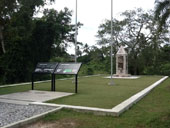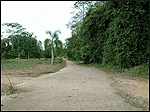 Gemencheh Bridge -
Gemencheh Ambush
Gemencheh Bridge -
Gemencheh Ambush
On 14th January 1942, Australian troops make a first
battle contact with Japanese in a successful ambush
attack on *Mukaide Force of the 5th Infantry Division
near Gemencheh River which connected Tampin and Gemas
trunk road. They were literally wiped out from the
Australian ambushed but due to quick action by General
Yamashita to reinforced the situation by sending fresh
troops from 5th Division which resting in Kuala Lumpur
to Gemas.
The ambush were laid by New South Wales 2/30 Battalion,
backed up by Queenslanders carefully were detailed
prepared by
Lt Col.
Galleghan.
The forwarded company covered 7 miles east of Gemencheh
River and was 3 miles in front of the main battalion HQ
position. The bridge were laid by demolition charges.
At 1620 hrs,
Captain D
J Duffy
Officer
Commanding `B' Company 2/30
allowed 500 Japanese cyclist to passed the bridge where
they will arrive at the killing zone and start to blown
out the bridge. Then the firing started from both side
of the road and some 400/500 Japanese soldiers were
killed. Mortars, grenades, Bren gun, automatic rifles
all joined up to struck the enemy.
The accuracy fire from soldiers who manned Bren guns and
Thompson automatic sub-machinegun positioning themselves
in a concealed position inflicted high casualties among
the Japanese cyclists. After a successful breakaway,
most of the ambush team retreat to their main battalion
position were they were readied to make some
counterattack near Gemas town.
But a platoon under Captain Duffy had a difficult time
reaching their main battalion. Being cut off by Japanese
who positioning themselves between them and Gemas, it
took 2 days for the party to return with 1 killed and
several wounded.
Now the area was called Kelamah River and authorities
put some memorial plaque near the battle site. The
remnant of the blown bridge still remained in the river
which another new bridge was built a few yards nearby.
 | |
 |
|
A memorial of Gemencheh ambush erected near the
demolished bridge. |
|
The area where Japanese cyclists were cut down.
Captain D J Duffy
Officer
together with his Forward Observation Officer
occupied the hill on the right side of this
photo. |
* Mukaide Detachment from 5th Division straight from
Kota Bharu landing campaign.
|